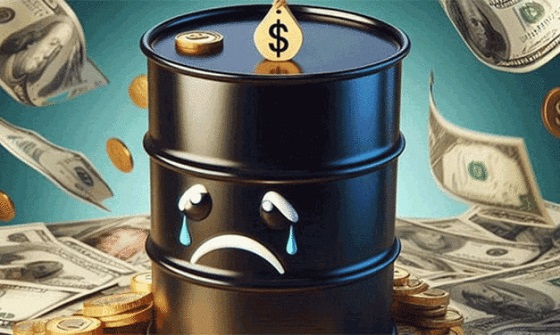Energy
Unleashing American Energy: America’s Silver Bullet

Energy Talking Points by Alex Epstein
|
|
It’s said that in politics there’s no silver bullet that’ll make everything better.
But we do have 1 silver bullet in the chamber: the opportunity to unleash American energy, which Donald Trump has rightly vowed to do.
- The single most important thing government can do to make our lives better—something that will lead to a better economy, a lower cost of living, more job opportunities, a lower deficit, greater security, and a better environment—is unleash abundant, affordable, American energy.
- If we unleash abundant, affordable, American oil, natural gas, and coal production from the anti-energy policies holding it back, we can go from crippling inflation—substantially driven by energy costs—to affordable food, housing, transportation, and heating bills.
- Unleashing American energy will take us from nationwide electricity shortages to affordable, reliable power for all—and from losing good job opportunities to China, which we’ve allowed to outcompete us on energy costs, to creating millions of new well-paying jobs here at home.
- Unleashing American energy will take us from begging OPEC+ for oil, depending on Russia for uranium, and being at China’s mercy for critical minerals, to producing an abundant and secure supply of these crucial commodities at home.
- Many Americans are hesitant to embrace policies that unleash abundant, affordable energy because they think it will harm environmental progress—progress in air and water quality, safety from climate, and enjoyment of nature. Nothing could be further from the truth.
- Environmental progress isn’t in conflict with abundant, affordable energy; it requires abundant, affordable energy—to afford pollution controls, to clean up natural environmental hazards, and to protect ourselves from the always-dynamic and dangerous climate.
- Thanks to abundant, affordable energy, America has been wealthy enough to innovate and adopt pollution controls that make our air far cleaner—which is why America was able to increase its fossil fuel use 25% since 1970 while reducing air pollution 78%.¹
- Thanks to abundant, affordable energy, America has been able to clean up natural environmental hazards such as undrinkable water, which requires affordable, reliable energy to purify, or mosquito-infested swamps, which require abundant, affordable energy to drain.
- Thanks to abundant, affordable energy, we can protect ourselves from the always-dangerous climate by powering heating and A/C systems, storm warning and evacuation systems, and irrigation systems; witness the 98% drop in climate-related disaster deaths over the last century.²
- Thanks to abundant, affordable energy we have the wealth we need to enjoy and preserve the most valuable and beautiful parts of nature—which is why America is able to be both the world’s economic superpower and a place of unsurpassed access to the great outdoors.
- The key to supporting America’s energy abundance and environmental progress is maintaining steadfast support of individual and economic freedom, including the protection of property rights.
- Property rights allow our energy companies to produce and innovate as they judge best. The shale revolution happened here because we alone protect underground property rights. Producers used this freedom to figure out how to extract abundant oil and gas from once-useless rocks.
- Property rights allow us to care for our environment on our own property—and people tend to care best for what they own. And property rights are the basis for laws protecting our air and water from dangerous levels of pollution.
- America has shown time and again that pro-freedom energy and environmental policies drive energy and environmental progress. And we can do it again, if we reverse the anti-freedom policies of the past several decades and embrace the following “energy freedom” policies.
- To aid America in unleashing American energy, I’ve created the Energy Freedom Plan—a comprehensive plan that includes hundreds of high-leverage policy changes for every aspect of energy, from drilling to pipelines to electricity to nuclear to rare earth elements.
- The Energy Freedom Plan is based on 5 game-changing goals:
- Unleash responsible development
- End preferences for unreliable electricity
- Set environmental standards using cost-benefit analysis
- Address climate danger through resilience and innovation
- Unleash nuclear energy
- Unleash responsible development
Anti-development policies prevent the drilling, mining, transporting, and building all energy needs to reach its potential—from natural gas to nuclear to solar.
Liberating responsible development will create unprecedented US energy abundance.
- End preferences for unreliable electricity
Our grid is being ruined by systemic preferences for unreliable electricity, which cause prices to rise and reliability to decline.
Ending these preferences and prioritizing reliability is needed to make power cheap and reliable again.
- Set environmental standards using cost-benefit analysis
The EPA harms prosperity and health via emissions standards that impose huge costs for little or no benefit.
Real cost-benefit analysis, including objective health science will promote prosperity and environmental quality.
- Address climate danger through resilience and innovation, not punishing America
“Climate policy”” that singles out US emissions makes us poorer and less resilient while global emissions go up.
Becoming more resilient and unleashing innovation are the keys to climate safety.
- Unleash nuclear energy from pseudo-scientific restrictions
The strangulation of nuclear has made it 10 times more expensive than it needs to be.
Unleashing nuclear, including getting rid of pseudoscientific policies like LNT and ALARA, will make possible a nuclear renaissance.
- This week I will be releasing the FULL Energy Freedom Plan, including over 100 SPECIFIC game-changing policies that can unleash American energy like never before.
To make sure you see the whole plan, follow me @AlexEpstein and especially subscribe to alexepstein.substack.com.
Questions about this article? Ask AlexAI, my chatbot for energy and climate answers:
Popular links
- EnergyTalkingPoints.com: Hundreds of concise, powerful, well-referenced talking points on energy, environmental, and climate issues.
- My new book Fossil Future: Why Global Human Flourishing Requires More Oil, Coal, and Natural Gas—Not Less.
- Speaking and media inquiries
“Energy Talking Points by Alex Epstein” is my free Substack newsletter designed to give as many people as possible access to concise, powerful, well-referenced talking points on the latest energy, environmental, and climate issues from a pro-human, pro-energy perspective.
Share Energy Talking Points by Alex Epstein
For every million people on earth, annual deaths from climate-related causes (extreme temperature, drought, flood, storms, wildfires) declined 98%–from an average of 247 per year during the 1920s to 2.5 per year during the 2010s.
Data on disaster deaths come from EM-DAT, CRED / UCLouvain, Brussels, Belgium – www.emdat.be (D. Guha-Sapir).
Population estimates for the 1920s from the Maddison Database 2010, the Groningen Growth and Development Centre, Faculty of Economics and Business at University of Groningen. For years not shown, population is assumed to have grown at a steady rate.
Population estimates for the 2010s come from World Bank Data.
Energy
75 per cent of Canadians support the construction of new pipelines to the East Coast and British Columbia

-
71 per cent of Canadians find the approval process too long.
-
67 per cent of Quebecers support the Marinvest Energy natural gas project.
“While there has always been a clear majority of Canadians supporting the development of new pipelines, it seems that the trade dispute has helped firm up this support,” says Gabriel Giguère, senior policy analyst at the MEI. “From coast to coast, Canadians appreciate the importance of the energy industry to our prosperity.”
Three-quarters of Canadians support constructing new pipelines to ports in Eastern Canada or British Columbia in order to diversify our export markets for oil and gas.
This proportion is 14 percentage points higher than it was last year, with the “strongly agree” category accounting for almost all of the increase.
For its part, Marinvest Energy’s natural gas pipeline and liquefaction plant project, in Quebec’s North Shore region, is supported by 67 per cent of Quebecers polled, who see it as a way to reduce European dependence on Russian natural gas.
Moreover, 54 per cent of Quebecers now say they support the development of the province’s own oil resources. This represents a six-point increase over last year.
“This year again, we see that this preconceived notion according to which Quebecers oppose energy development is false,” says Mr. Giguère. “Quebecers’ increased support for pipeline projects should signal to politicians that there is social acceptability, whatever certain lobby groups might think.”
It is also the case that seven in ten Canadians (71 per cent) think the approval process for major projects, including environmental assessments, is too long and should be reformed. In Quebec, 63 per cent are of this opinion.
The federal Bill C-5 and Quebec Bill 5 seem to respond to these concerns by trying to accelerate the approval of certain large projects selected by governments.
In July, the MEI recommended a revision of the assessment process in order to make it swift by default instead of creating a way to bypass it as Bill C-5 and Bill 5 do.
“Canadians understand that the burdensome assessment process undermines our prosperity and the creation of good, well-paid jobs,” says Mr. Giguère. “While the recent bills to accelerate projects of national interest are a step in the right direction, it would be better simply to reform the assessment process so that it works, rather than creating a workaround.”
A sample of 1,159 Canadians aged 18 and older were surveyed between November 27 and December 2, 2025. The results are accurate to within ± 3.5 percentage points, 19 times out of 20.
Business
Geopolitics no longer drives oil prices the way it used to

This article supplied by Troy Media.
Oil markets are shrugging off war and sanctions, a sign that oversupply now matters more than disruption
Oil producers hoping geopolitics would lift prices are running into a harsh reality. Markets are brushing off wars and sanctions as traders focus instead on expectations of a deep and persistent oil glut.
That shift was evident last week. Despite several geopolitical developments that would once have pushed prices higher, including the U.S. seizure of a Venezuelan crude tanker and fresh Ukrainian strikes on Russian energy infrastructure, oil markets barely reacted, with prices ending the week lower.
Brent crude settled Friday at US$61.12 a barrel and U.S. West Texas Intermediate at US$57.44, capping a weekly drop of more than four per cent.
Instead of responding to disruption headlines, markets were reacting to a different risk. Bearish sentiment, rather than geopolitics, continued to dominate as expectations of a “2026 glut” took centre stage.
At the heart of that outlook is a growing supply overhang. The oil market is grappling with whether sanctioned Russian and Iranian cargoes should still be counted as supply. That uncertainty helps explain why prices have been slow to react to a glut that is already forming on the water, said Carol Ryan, writing for The Wall Street Journal.
The scale of that buildup is significant. There are 1.4 billion barrels of oil “on the water,” 24 per cent higher than the average for this time of year between 2016 and 2024, according to oil analytics firm Vortexa. These figures capture shipments still in transit or cargoes that have yet to find a buyer, a clear sign that supply is running ahead of immediate demand.
Official forecasts have reinforced that view. Last week, the International Energy Agency trimmed its projected 2026 surplus to 3.84 million barrels per day, down from 4.09 million barrels per day projected previously. Even so, the IEA still sees a large oversupply relative to global demand.
Demand growth offers little relief. The IEA expects growth of 830 kb/d (thousand barrels per day) in 2025 and 860 kb/d in 2026, with petrochemical feedstocks accounting for a larger share of incremental demand. That pace remains modest against the volume of supply coming to market.
OPEC, however, has offered a different assessment. In its latest report, the group pointed to a near balance, forecasting demand for OPEC+ crude averaging about 43 million barrels per day in 2026, roughly in line with what it produced in November.
Reflecting that confidence. OPEC+ kept policy steady late in November, pausing planned output hikes for the first quarter of 2026 while more than three million barrels per day of cuts remain in place. Those measures are supportive in theory, but markets have shown little sign of being persuaded.
Recent geopolitical events underline that scepticism. The ongoing Russia-Ukraine war and Ukrainian strikes on Russian energy infrastructure, including reported hits on facilities such as the Slavneft-YANOS refinery in Yaroslavl, again failed to lift prices. Russia-Ukraine headlines pulled prices down more than strikes lifted them, according to media reports, suggesting traders were more attuned to “peace deal” risk than to supply disruption.
Washington’s move against Venezuelan crude shipments offered another test. The U.S. seizure of a Venezuelan tanker, the first formal seizure under the 2019 sanctions framework, had a muted price impact, writes Marcin Frackiewicz of Oilprice.com.
Venezuela’s exports fell sharply in the days that followed, but markets remained largely unmoved. One explanation is that Venezuela’s output is no longer large enough to tighten global balances the way it once did, and that abundant global supply has reduced the geopolitical premium.
Taken together, the signal is hard to miss. Oil producers, including in Canada, face a reality check in a market that no longer rewards headlines, only discipline and demand.
Toronto-based Rashid Husain Syed is a highly regarded analyst specializing in energy and politics, particularly in the Middle East. In addition to his contributions to local and international newspapers, Rashid frequently lends his expertise as a speaker at global conferences. Organizations such as the Department of Energy in Washington and the International Energy Agency in Paris have sought his insights on global energy matters.
Troy Media empowers Canadian community news outlets by providing independent, insightful analysis and commentary. Our mission is to support local media in helping Canadians stay informed and engaged by delivering reliable content that strengthens community connections and deepens understanding across the country.
-

 Business2 days ago
Business2 days agoDeadlocked Jury Zeroes In on Alleged US$40 Million PPE Fraud in Linda Sun PRC Influence Case
-

 Business2 days ago
Business2 days agoGeopolitics no longer drives oil prices the way it used to
-

 Business2 days ago
Business2 days agoArgentina’s Milei delivers results free-market critics said wouldn’t work
-

 Business14 hours ago
Business14 hours agoThere’s No Bias at CBC News, You Say? Well, OK…
-

 International2 days ago
International2 days agoOttawa is still dodging the China interference threat
-

 espionage2 days ago
espionage2 days agoCarney Floor Crossing Raises Counterintelligence Questions aimed at China, Former Senior Mountie Argues
-

 Business1 day ago
Business1 day agoTaxing food is like slapping a surcharge on hunger. It needs to end
-

 Health23 hours ago
Health23 hours agoFDA warns ‘breast binder’ manufacturers to stop marketing to gender-confused girls














